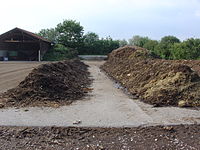
Beer lees and ceramsite amendments enhance the two-stage co-composting of green waste.
Sign Up to like & getrecommendations! Published in 2021 at "Bioresource technology"
DOI: 10.1016/j.biortech.2021.125288
Abstract: Composting is a major way to process green waste (GW), and amendments are important in GW composting. In this study of the two-stage co-composting of GW, beer lees (0, 25, 30%) and/or ceramsite (0, 10,… read more here.
Keywords: lees ceramsite; green waste; two stage; stage composting ... See more keywords

Effects of additives on physical, chemical, and microbiological properties during green waste composting.
Sign Up to like & getrecommendations! Published in 2021 at "Bioresource technology"
DOI: 10.1016/j.biortech.2021.125719
Abstract: Composting is an environmentally friendly and sustainable way to transform Green waste (GW) into a useful product. GW, however, contains substantial quantities of lignocelluloses that extend the composting period unless substances that accelerate composting are… read more here.
Keywords: green waste; physical chemical; waste; additives physical ... See more keywords

Bioethanol and biogas production: an alternative valorisation pathway for green waste.
Sign Up to like & getrecommendations! Published in 2022 at "Chemosphere"
DOI: 10.1016/j.chemosphere.2022.133970
Abstract: Biofuels are a research field of great interest given the environmental benefits they offer over conventional fossil fuels. Nowadays, it is urgent to find ways of utilizing waste in the direction of biofuels production. The… read more here.
Keywords: waste; valorisation; production; green waste ... See more keywords

Bamboo biochar amendment improves the growth and reproduction of Eisenia fetida and the quality of green waste vermicompost.
Sign Up to like & getrecommendations! Published in 2018 at "Ecotoxicology and environmental safety"
DOI: 10.1016/j.ecoenv.2018.03.023
Abstract: Vermicomposting is a promising method for reusing urban green waste. However, high lignin content in the green waste could hinder the development of earthworm and microorganisms and the vermicomposting process, resulting in a low-quality vermicompost… read more here.
Keywords: biochar addition; quality; vermicompost; green waste ... See more keywords

Synthesis of improved hydrochar by microwave hydrothermal carbonization of green waste
Sign Up to like & getrecommendations! Published in 2020 at "Fuel"
DOI: 10.1016/j.fuel.2020.117146
Abstract: Abstract Green waste (GW), a typical biomass waste, was used to produce hydrochar using microwave hydrothermal carbonization (MHTC). The results indicate that MHTC promotes the dehydration of GW to a greater extent than traditional oven… read more here.
Keywords: green waste; waste; hydrothermal carbonization; microwave hydrothermal ... See more keywords

Nitrogen amendment of green waste impacts microbial community, enzyme secretion and potential for lignocellulose decomposition
Sign Up to like & getrecommendations! Published in 2017 at "Process Biochemistry"
DOI: 10.1016/j.procbio.2016.11.002
Abstract: Abstract Microorganisms involved in biomass deconstruction are an important resource for organic waste recycling and enzymes for lignocellulose bioconversion. The goals of this study were to examine the impact of nitrogen amendment on microbial community… read more here.
Keywords: nitrogen; green waste; microbial community; nitrogen amendment ... See more keywords

Hydrochar derived from green waste by microwave hydrothermal carbonization
Sign Up to like & getrecommendations! Published in 2019 at "Renewable Energy"
DOI: 10.1016/j.renene.2018.09.041
Abstract: Abstract Green waste (GW), rich in cellulose and hemicellulose, is a valuable resource. Developing alternative sustainable technologies to utilize GW is attracting increasing attention. In this study, microwave hydrothermal carbonization (MHTC) process parameters including holding… read more here.
Keywords: green waste; hydrothermal carbonization; hydrochar; microwave hydrothermal ... See more keywords

Succession and diversity of microorganisms and their association with physicochemical properties during green waste thermophilic composting.
Sign Up to like & getrecommendations! Published in 2018 at "Waste management"
DOI: 10.1016/j.wasman.2017.12.026
Abstract: A comprehensive characterization of the bacterial diversity associated to thermophilic stages of green waste composting was achieved. In this study, eight different treatments (T1-T8) and three replicated lab-scale green waste composting were carried out to… read more here.
Keywords: particle size; green waste; diversity; waste ... See more keywords

Maintaining the ratio of hydrosoluble carbon and hydrosoluble nitrogen within the optimal range to accelerate green waste composting.
Sign Up to like & getrecommendations! Published in 2020 at "Waste management"
DOI: 10.1016/j.wasman.2020.02.023
Abstract: The recalcitrance of green waste, caused by its high lignocellulose content, is a technical challenge for accelerating green waste composting. Adjusting the initial ratio of total carbon and total nitrogen (TC/TN) to the optimal range… read more here.
Keywords: optimal range; green waste; carbon; waste ... See more keywords

IDENTIFYING THE KEY ENVIRONMENTAL FACTORS AND BACTERIAL COMMUNITIES IN HUMIFICATION AND THEIR RELATIONSHIPS DURING GREEN WASTE COMPOSTING
Sign Up to like & getrecommendations! Published in 2021 at "Applied Ecology and Environmental Research"
DOI: 10.15666/aeer/1901_045062
Abstract: In this study, the key factors affecting the formation of humic substances (HS) during green waste composting(GWC) and their potential relationships were investigated by setting up different initial particle sizes (IPS) (2 and 5 mm)… read more here.
Keywords: key environmental; waste composting; green waste; environmental factors ... See more keywords

Using green waste as substrate to produce biostimulant and biopesticide products through solid-state fermentation.
Sign Up to like & getrecommendations! Published in 2023 at "Waste management"
DOI: 10.2139/ssrn.4282793
Abstract: Although the use of green waste as a substrate in different types of microbial bioprocessing has a major impact on improving green waste valorization, very little information has been provided on this issue. The purpose… read more here.
Keywords: waste; waste substrate; grass; spore ... See more keywords